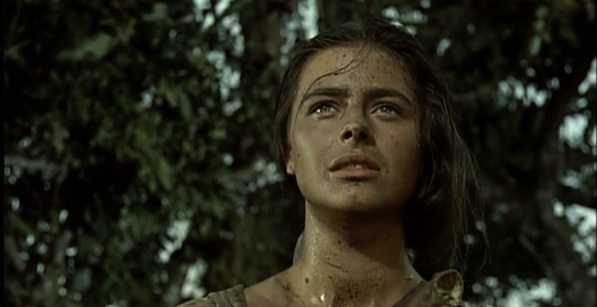Watch Luis Buñuel’s Death in the Garden, featuring French stars Michel Piccoli and Simone Signoret, and see which of the following reviews you agree with:
This 1956 French-Mexican production was obviously designed as escapist entertainment, but in the hands of director Luis Bunuel it becomes a little more than that. As things get curiouser and curiouser, it’s interesting to see how close Bunuel’s surrealist vision is to the expected extravagancies of genre filmmaking. No masterpiece, but a prime example of subversive cinema.
– Dave Kehr, The Chicago Reader
Death in the Garden is fun to watch, full of Buñuel’s trademark pranksterism and evocative imagery. He plays it larger here, enjoying the wide emotional expanse the potboiler provides him. I do think, however, that the more focused first half is more interesting. The communist-leaning message gives Death in the Garden some bite, and the action sequences and dirty dealing make for an exciting plot. The jungle trek, on the other hand, feels more conventional and overly long. The broad strokes don’t work as well on the confined canvas.
– Jamie S. Rich, DVD Talk
The movie’s cast should be enough to entice film buffs and older viewers: Simone Signoret, as empathetic and real as it gets, taking us through one change of heart, not to mention plan, after another as the town’s favorite prostitute; Michel Piccoli (who was in quite a few Buñuel films and appeared in some 222 film and TV appearances), is handsome and riveting as the concerned priest, one of his earlier roles; the fine French actor Charles Vanel (Wages of Fear), smart and stoic as the wise old man; and an angelically beautiful young Michèle Girardon, graceful and sweet in her film debut as Vanel’s mute daughter. Second-tier French hunk Georges Marchal as the scoundrel/hero, is properly blond, strong and muscular as the leader of the troupe (he also brings a believable and quite necessary dark side to his strength: notice his treatment of the Signoret character, post-betrayal).
Buñuel knows how to keep the action moving, not by flashy editing but rather via smart plot turns and the slow delineation of character. We don’t fully understand these people until the film is nearly over; then, what has happened makes its own dark sense.
– James van Maanen, GreenCine
There’s an extraordinary moment when the body of a headless python, killed by the fugitives for their supper, suddenly seems to come alive again as it is attacked by an army of ants. That one image could be one entire movie. In another scene, Mr. Piccoli, the priest, recalls for no easily apparent reason a story about a fellow seminarian who once had a compulsion to eat poached eggs. In moments like this, one glimpses Buñuel’s appreciation for the act of disorder.
– Vincent Canby, The New York Times
The movie is all set to be a paean to the redemptive power of nature, hardship, or love, or something, as the variously avaricious or hypocritical characters are genuinely transfigured by their journey away from material possessions and into the wild. But nothing so simple or benevolent would satisfy Buñuel. His malign universe rains on the just and unjust alike, sometimes doling out spectacularly unfair punishments tinged with a nasty sense of humor we might recognize as the filmmaker’s own.
– David Cairns, The Auteurs Notebook
This pulsating adventure tale is filled with philosophical musings, the questioning of the certainty of beliefs and the examination of Marxist truths under duress. It’s a Buñuel film alright filled with hints of surrealism and plenty of unique Buñuel moments, but with a potboiler story line that even a Sam Fuller might not match in intensity, action and perversity.
– Dennis Schwartz, Ozu’s World Movie Reviews
This tale of heated passions and broken dreams was noticeably compromised by an insufferable shooting schedule. Buñuel had little financing for the project and was burdened by the constant changes being made to the script. More troublesome, though, was Signoret. According to Buñuel, the unruly actress missed her husband Yves Montand so much that “on her way to join us in Mexico, she slipped some Communist documents into her passport, hoping to be turned away by American Immigration.”
– Ed Gonzalez, Slant
In his DVD commentary, Ernesto R. Acevedo-Munoz demerits the picture as “minor Buñuel,” but is there such a thing? Author of Buñuel and Mexico: The Crisis of National Cinema, he nearly retracts his own statement when discussing Death in the Garden’s characters, their outward façades and the “devolution from civility to savagery” as the action moves from village to jungle — a trip he equates with Marlow’s odyssey in Conrad’s Heart of Darkness. “Death in the Garden is one of the classically structured Buñuel movies,” he says, “but even within the classical structure it violates conventions of narrative.”
– Ray Young, Flickhead




